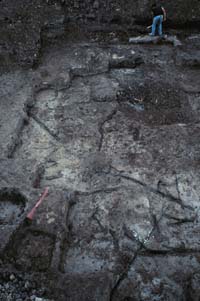
Prairie has not always dominated the Illinois landscape. Glacial ice, steppe or tundra-like vegetation, and deciduous and coniferous forests have covered the state.
Glaciers have advanced and retreated many times over the last 1.8 million years (scientists refer to this time period as the Pleistocene).
During the last two glaciations, the Illinois and the Wisconsin, ice covered major portions of the state.
- During the Illinois, 186,000 to 128,000 years ago, ice covered most of Illinois.

Much of what we know about the changing plant communities and past environments in Illinois is based on fossil pollen. (use back button to return here) Many plants are wind pollinated, and some of this pollen falls or is washed into lakes and wetlands, where it is preserved in the sediments.
Scientists have learned what the forests in different areas of Illinois looked like by studying fossil pollen.
Southern
Illinois
Pollen data from several sites in southern Illinois provide some information on plant communities present during the late Illinois and early Wisconsin Ice Ages, and the time between the two glaciers.
End of the Illinois glacierNorthern and Central Illinois
These data show that when the Illinoisian ice retreated, a conifer forest grew and covered southern Illinois. The dominant trees were spruce and pine. Today, this type of forest exists along the Canadian border with the United States and northward. So we know the climate must have been cool.Between glaciers (Interglacial)
The climate between glacial periods first became warmer and wetter, and the conifer forest was replaced (slowly and gradually) by a deciduous forest characteristic in more temperate climates. The dominant trees were oak, elm, hickory, and beech. As the climate continued to become warmer and drier, savanna-type vegetation developed. Grasses, ragweed, and oak became most common.Arrival of the Wisconsin glacier
A deciduous forest developed at the end of the last interglacial as conditions became moister. As the Wisconsin ice advanced the climate became drier and cooler. Open spruce forests developed by the end of the Wisconsin glaciation. This type of forest prefers a cooler and drier climate than does a deciduous forest.
Pollen data from Biggsville, a site in northwestern Illinois, provide a record of plants growing during a period that occurred just before the Wisconsin ice advanced into Illinois - a time from approximately 36,000 to 30,000 years ago.
The Wisconsin glacier arrives
At the beginning of this period, jack pine and spruce were common, but spruce became more dominant as climate became cooler. Pine had disappeared by the time the glaciers advanced into Illinois. The Wisconsin glacier overrode a spruce forest (use back button to return here) as it advanced into central Illinois.Along the glacier margin, tundra developed, and this persisted for some time after the glacier retreated. Sedges (grass-like plants) were common in the tundra vegetation.
 |
Buried spruce logs, Tonica Illinois |
|
|
Copyright © 2000 Illinois State Museum